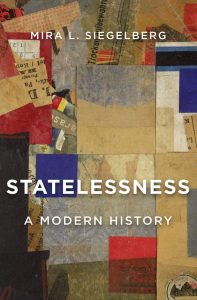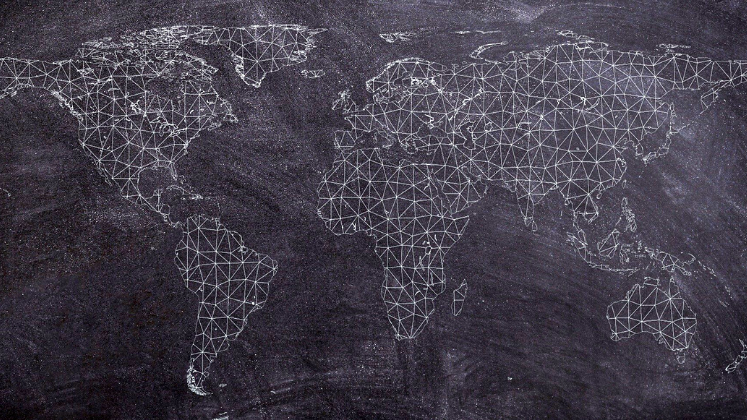In Statelessness: A Modern History, Mira L. Siegelberg traces the emergence and codification of statelessness – the condition of not possessing citizenship and the rights and benefits attached to it in any state – and its impact on the boundaries of the interstate order during, in between and following the First and Second World Wars. This is a compelling and impressive contribution that demonstrates how statelessness intertwines with other foundational political concepts, such as sovereignty, citizenship and human rights, and invites readers to think about the predicament of stateless people today, writes Isadora Dullaert.
Statelessness: A Modern History. Mira L. Siegelberg. Harvard University Press. 2020.
 Find this book (affiliate link):
Find this book (affiliate link):![]()
Citizenship matters. As Maha Mamo, a formerly stateless person, current citizen of Brazil and lifelong citizenship activist, put it: ‘for most people, like you, it’s just a technicality, a document in the shape of a small book, with a coloured cover, that allows you to travel. But, for me, it was life. It was a sign that I belong somewhere.’ Belonging somewhere, being protected by a state and possessing rights and privileges, is important in a world that is constituted by (nation) states. This world is the product of extensive legal and political debates.
In a compelling new book, Statelessness: A Modern History, Mira L. Siegelberg, lecturer in the History of International Political Thought at the University of Cambridge, traces the emergence and codification of statelessness and its impact on the boundaries of the interstate order. Situated at the intersection of history and political and legal theory, her analysis convincingly shows how statelessness – the condition of not possessing citizenship and the rights and benefits attached to it in any state – has changed during, in between and after the First and Second World Wars. This is an impressive work that shows the impact of legal thought on social reality and the significance of possessing a (legal) identity – both at the beginning of the twentieth century and today.
Siegelberg starts off by illustrating the newness of statelessness as a legal category by highlighting one specific case after the First World War. Max Stoeck, Prussian emigré and businessman in London, became an unwanted alien when the war broke out in 1914. He filed a lawsuit against the UK government, pleading his case to become a stateless person, in the hope of being able to stay and to regain his seized property. This individual case, Siegelberg argues, is significant, as the ruling in Stoeck’s favour resulted in the establishment of a new category in English law. It was henceforth possible to be neither a citizen nor a foreigner, but a stateless person. Furthermore, the fact that the English court had recognised German law – according to which Stoeck had lost his nationality – raised questions about states’ sovereign right to determine nationality. Siegelberg thus places debates about the concept of statelessness in a broader context and shows how it impacted other concepts, such as sovereignty, as well as the development of international law.

Siegelberg expands on this relationship in the second chapter, where she discusses the dissolution of empires, such as the Habsburg Empire, and new forms of international governance, notably the League of Nations, that emerged in response to this. The increasing number of stateless people and refugees made further reflection on this situation (as well as international cooperation) necessary. Siegelberg highlights legal and political ideas about these issues in the third chapter, where she asks why legal debates were so instrumental in establishing the boundaries of citizenship and nationality. Here, she mentions various thinkers, such as sociologist Max Weber, jurist Lassa Oppenheim and international lawyer Hersch Lauterpacht.
Most prominent in this chapter, however, is the work of legal philosopher Hans Kelsen, who specialised in the issue of statelessness. According to Kelsen, states are representations of the legal order. Whether a person could claim statelessness would therefore depend on the (legal) boundaries of the state rather than on their ties to a particular political community. As Siegelberg points out, this raises questions about the relationship between law and social reality – does law generate social reality or merely make it legible? Critics at the time also thought along these lines, objecting that this abstract theory fails to account for the reality of political struggles.
The Second World War gave rise to new ideas about the concept of statelessness and, relatedly, about citizenship, sovereignty and human rights. In Chapters Five and Six, Siegelberg describes how theorists started emphasising the importance of sovereignty – instead of using statelessness as an argument against the power of individual states, they began to understand ‘their work as part of the development of a new world order premised on the sovereign equality of states’ (194). Around the same time, however, human rights were codified in the Universal Declaration of Human Rights, which was preceded by the questions of which rights people deserve (for example, a right to nationality) and who could decide. Stateless persons fell between the cracks of different legal frameworks – Siegelberg later points out that they thus in fact ‘embody the contradiction between sovereignty and human rights’ (229).
It was also around this time that the conceptualisation of statelessness moved from a legal to a more sociological interpretation. Siegelberg mentions, for example, the landmark Nottebohm (Liechtenstein vs. Guatemala) case of 1955, where the judge ruled that citizenship requires a ‘real’ and ‘genuine’ bond with a state. This new legal precedent made it possible for governments to argue that legislation on membership should include sociological factors. This was, therefore, a departure from early conceptualisations of citizenship and statelessness, where law was seen as a contributing factor in the making of social reality, toward a more sociologically grounded and normative interpretation.
Above everything else, Siegelberg’s book thus reminds the reader of the importance of ideas. Legal thought has contributed to the creation of the ontological reality in which statelessness is a status that has real implications. Her demonstration of how political struggles and legal and political thought have influenced each other is very impressive: she has transformed legal history into a chronological story, where thinkers follow each other in a logical fashion, reflecting on political breakdown as well as each other’s ideas. Furthermore, the way in which she weaves together theorists’ personal backgrounds, their contributions and historical context makes the reader really understand how their ideas came about.
While there are other books that focus on legal identity, notably John Torpey’s seminal work The Invention of the Passport, Siegelberg’s text is an important contribution, as she makes the understudied topic of statelessness intelligible and, on top of that, demonstrates how it intertwines with other foundational political concepts, such as sovereignty, citizenship and human rights. As such, the book helps readers realise that the question of statelessness has in fact been central to the establishment of our current legal and political order. Furthermore, while the material is complex, Siegelberg writes about it in an accessible way; both academic and non-academic audiences will be able to enjoy this work. Her writing flows and is sometimes close to poetic. For example, phrases such as ‘the collapse of a world that had seemed to possess perpetual life left enormous uncertainty in its wake […]’ (59) make reading about the disintegration of empires more enjoyable than one might initially think.
Importantly, understanding the conceptual history of statelessness forces us to think about the predicament of stateless people today. As Siegelberg points out in her excellent conclusion, which connects past to present, the catastrophes of our times will undoubtedly lead to mass displacement and de facto statelessness. She asks: ‘in a new era of climate change and mass migration, what will be the definition of statehood, and who will decide?’ (233). If anything, Siegelberg has shown that political concepts are always in flux – while today’s challenges might be different, it is up to us to continue to reflect on (and change) the political order, just like the people who grappled with the changing world around them in the last century.
- This article originally appeared at the LSE Review of Books.
- Banner Image Credit: Image by jacqueline macou from Pixabay.; In-text Image Credit: Image by BULENT UNER from Pixabay.
Please read our comments policy before commenting.
Note: This article gives the views of the authors, and not the position of USAPP– American Politics and Policy, nor of the London School of Economics.
Shortened URL for this post: https://bit.ly/2Oujdgr
About the reviewer
Isadora Dullaert – The University of Edinburgh
Isadora Dullaert holds an MA in Legal and Political Theory from UCL and an MSc in Nationalism Studies from The University of Edinburgh, and is currently doing a PhD in Sociology at that same university. Her research interests include citizenship, migration, borders and passports. She is particularly interested in biometric borders and the digital identities that are generated to cross them.






